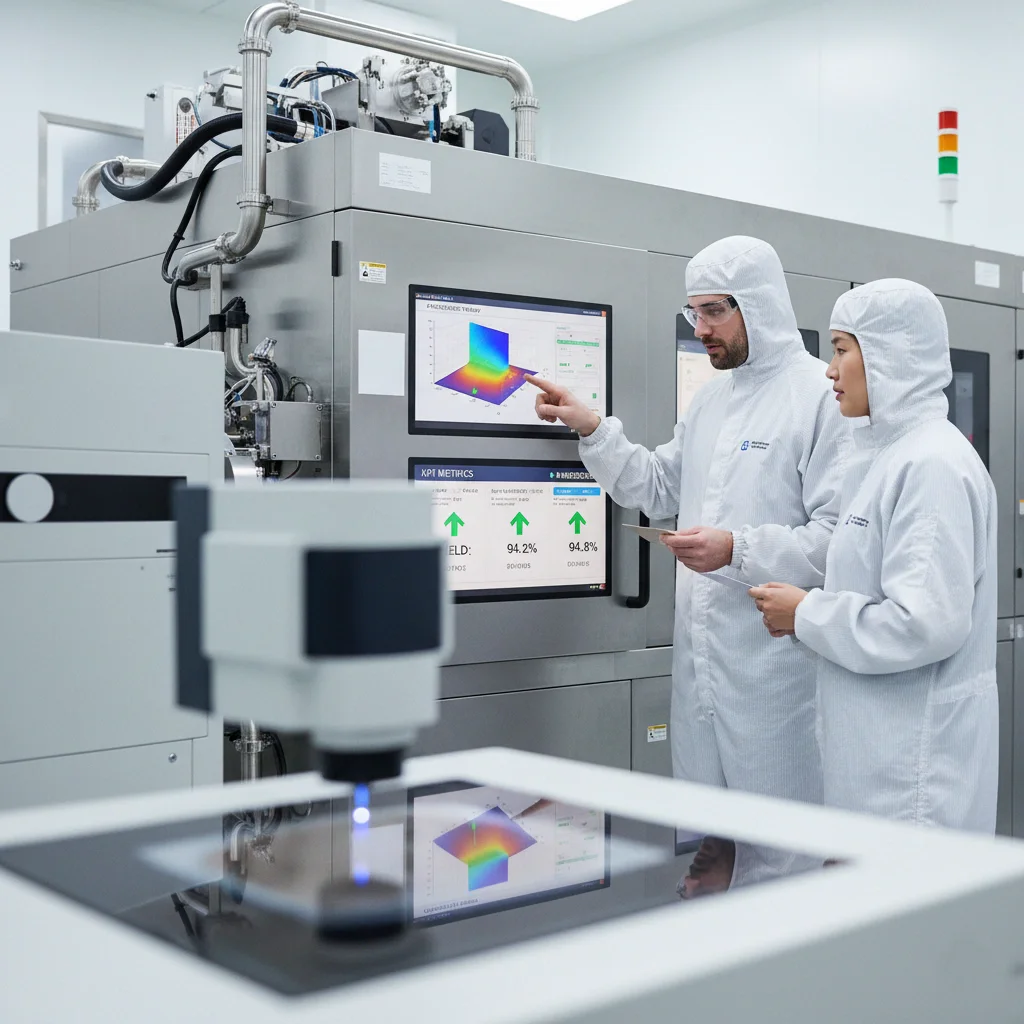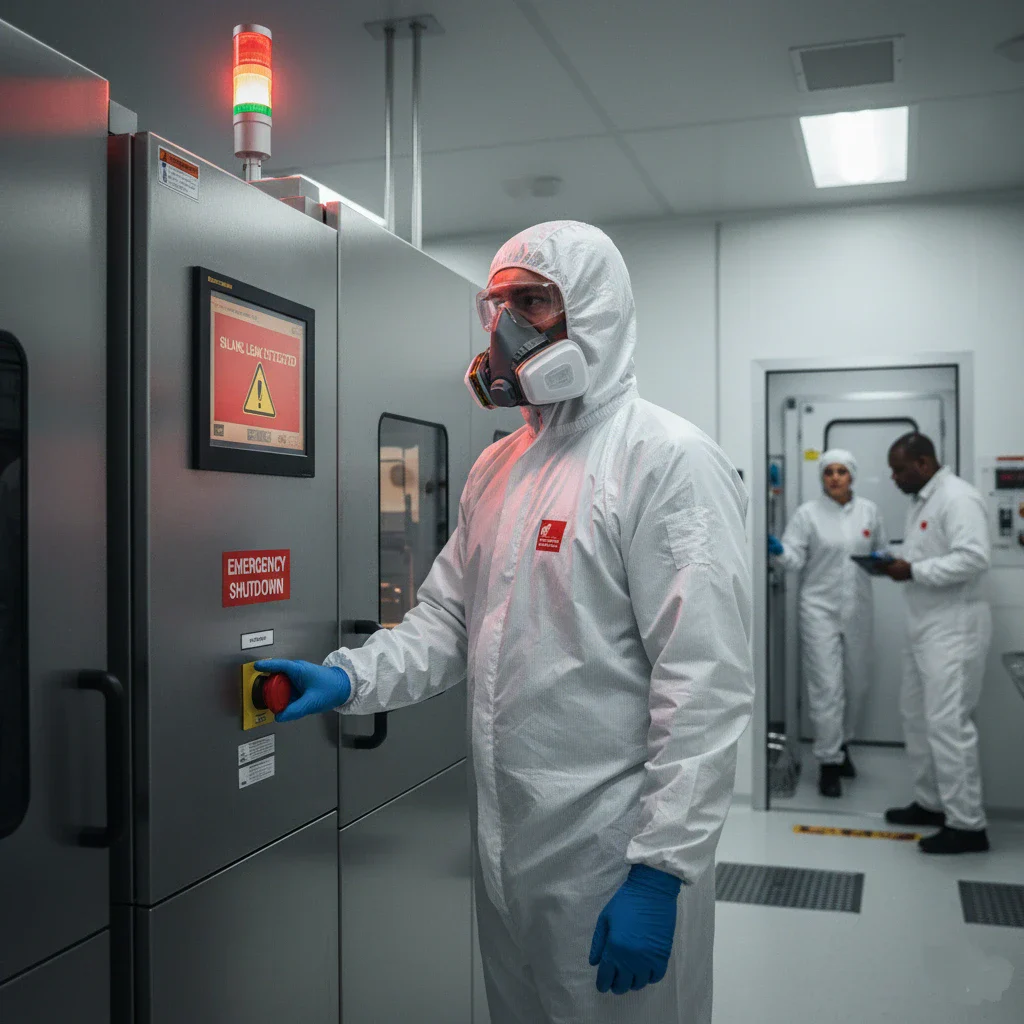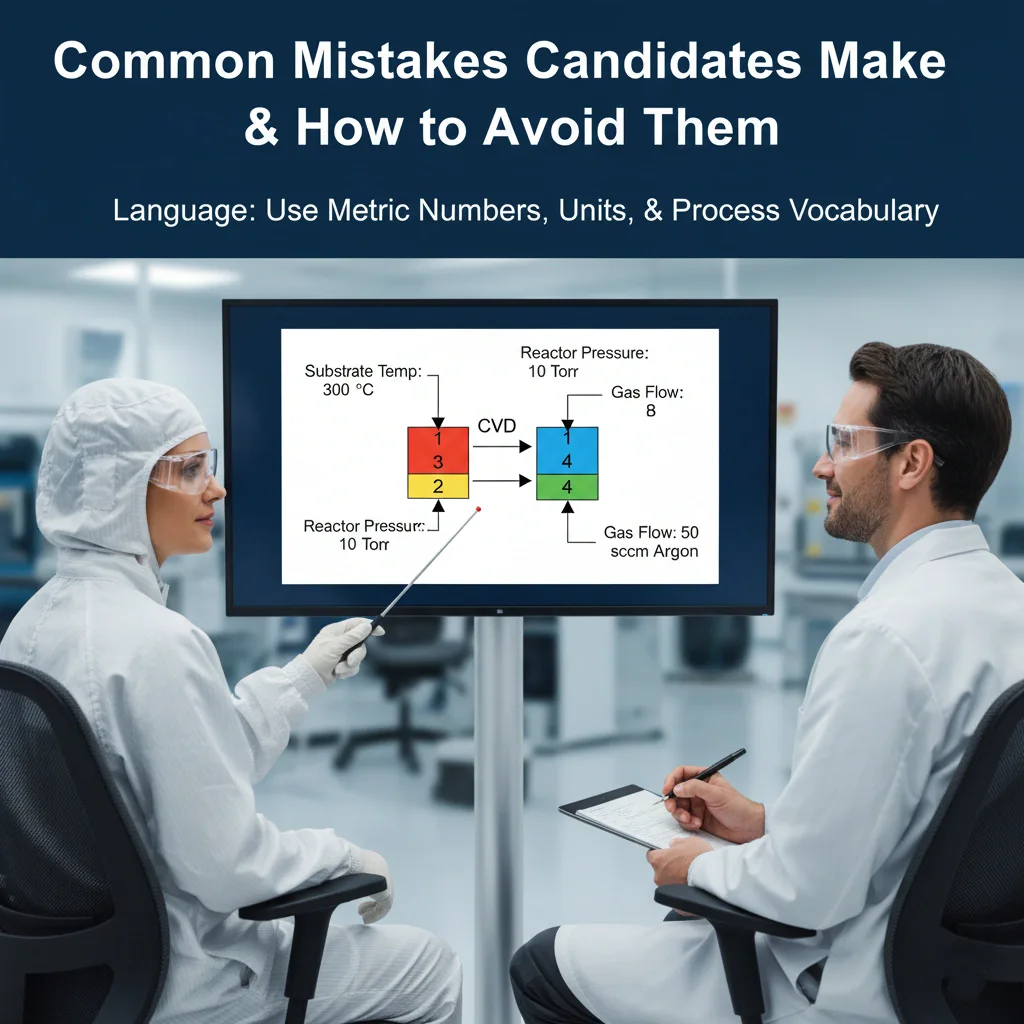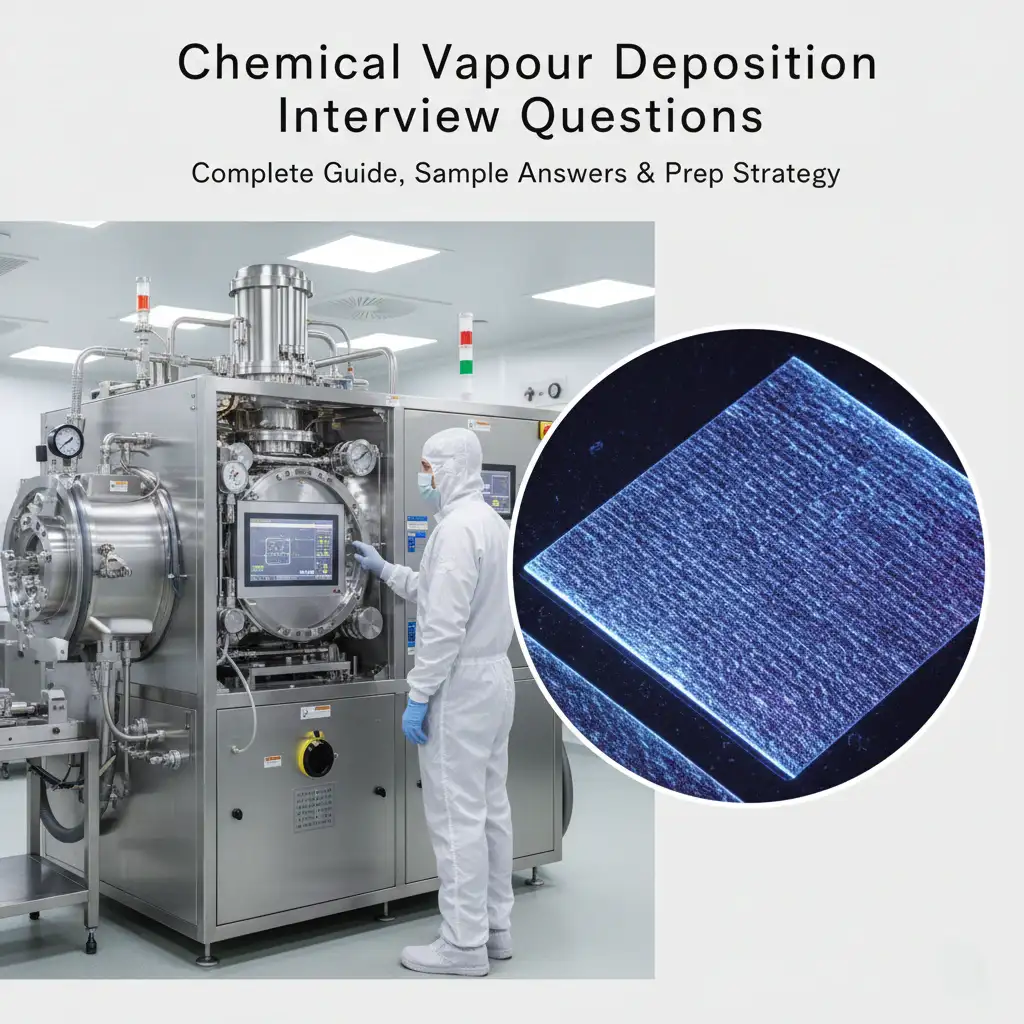Landing a chemical vapour deposition (CVD) role whether as a process engineer, technician, or research scientist requires nailing a range of interview questions, from technical fundamentals to behavioral scenarios. This guide is your all-in-one resource, offering clear explanations, role-specific insights, troubleshooting tips, and STAR-based sample answers tailored to CVD interviews. Designed to align with Google’s August 2024 Core Update for people-first content, it draws on real-world expertise to help you confidently tackle screening calls, technical panels, and hands-on assessments. Practice these answers aloud, and you’ll be ready to shine.
What Recruiters Mean by Chemical Vapour Deposition Interview Questions
Understanding the types of questions and interview formats helps you prepare strategically, aligning your answers with what recruiters value most.
Searcher Intent: Technical vs Behavioral vs Role-Fit Questions
Recruiters test three key areas:
- Technical: Core CVD principles, reactor chemistry, and metrology (e.g., ellipsometry, SEM).
- Behavioral: Teamwork, problem-solving, and safety mindset, often using STAR (Situation, Task, Action, Result) prompts.
- Role-Fit: Specific tasks tied to the job, like MOCVD operations for engineers or MFC calibration for technicians.
For phone screens, keep technical answers concise (30–60 seconds). In panels, use STAR for behavioral questions to show structured thinking.
Typical Interview Formats for CVD Roles
- Phone Screen: 20–30 minutes, verifying resume basics and CVD fundamentals.
- Technical Interview/Panel: 45–60 minutes, diving into process details with follow-up questions.
- Hands-On/Practical Test: Equipment checks, SOP execution, or lab demos (e.g., chamber setup).
- On-Site Tour & Cultural Fit: Cleanroom behavior, safety protocols, and team interaction assessed.
How to Read the Job Posting for CVD Process Engineer vs Technician vs Researcher
Analyze the job description for keywords:
- Process Engineer: Terms like “scale-up,” “yield optimization,” “process window” signal focus on production metrics.
- Technician: Look for “maintenance,” “SOP compliance,” “MFC calibration” to emphasize operational tasks.
- Researcher: Expect “experiment design,” “novel materials,” “publications” for innovation-driven roles.
Tailor your answers with examples matching these terms, like improving yield by 5% for an engineer role.
Core Technical CVD Interview Questions Every Candidate Must Master
Master these foundational questions to build confidence across roles, from entry-level to senior positions.
Explain: What is Chemical Vapour Deposition (CVD)? — Concise, Interview-Ready Answer
Sample Answer (30–60s):
“CVD is a process to deposit thin films by reacting gaseous precursors on a heated substrate, forming a solid layer. It’s widely used in semiconductors, solar cells, and coatings for its uniform, high-quality films. For example, silicon dioxide is often grown using silane and oxygen in a CVD reactor.”
Tip: Start simple, then offer a specific application (e.g., SiO₂ for chips) if prompted for depth.
Compare: CVD vs PVD vs ALD — Phrasing to Earn Points in Interviews
Sample Answer:
- PVD (Physical Vapor Deposition): Deposits material via physical vapor from a solid target, like sputtering. It’s line-of-sight, ideal for metal films like copper interconnects.
- CVD: Uses gas-phase chemical reactions for deposition, offering conformal coatings on complex shapes, like polysilicon for transistors.
- ALD (Atomic Layer Deposition): Builds films layer-by-layer with self-limiting reactions, perfect for ultrathin, conformal dielectrics in nanoscale devices.
Tip: Add a use-case for each to show practical knowledge (e.g., ALD for high-k gate oxides).
Describe: Types of CVD (LPCVD, APCVD, PECVD, MOCVD) and When to Use Each
Sample Answer:
- LPCVD (Low-Pressure): Operates at reduced pressure for uniform, high-quality films; used for silicon nitride in ICs.
- APCVD (Atmospheric): Simpler, faster setup for large substrates, like glass coatings in solar panels.
- PECVD (Plasma-Enhanced): Uses plasma to lower deposition temperatures, ideal for heat-sensitive substrates like OLEDs.
- MOCVD (Metal-Organic): Employs organometallic precursors for III-V semiconductors, like GaN for LEDs.
Tip: Tie each type to a real-world application to demonstrate industry awareness.
Key Process Parameters: Temperature, Pressure, Precursor Flow, Carrier Gas
Sample Answer:
“Temperature drives reaction rates higher temps speed up deposition but risk defects. Pressure influences gas diffusion; low pressure ensures uniformity in LPCVD. Precursor flow controls material delivery, while carrier gases like nitrogen or argon stabilize transport and affect film quality. For example, in PECVD, balancing plasma power and flow prevents film stress.”
Tip: If asked about tradeoffs, mention mass-transport-limited (flow-driven) vs surface-reaction-limited (temp-driven) regimes.
Example Chemistries: Common CVD Reactions and Byproducts
Sample Answer:
“For titanium nitride (TiN), we use TiCl₄ with N₂ and H₂, depositing a conductive film for barriers in chips. A byproduct, HCl, requires exhaust scrubbing to ensure safety. Another example is SiO₂ from silane (SiH₄) and O₂, producing water vapor as a byproduct.”
Tip: Highlight safety (e.g., scrubbers) and stick to common, safe examples unless asked for specifics.
Role-Specific CVD Interview Questions (Tailored Q&A)

Questions vary by role, so customize your prep to match the job’s focus.
CVD Process Engineer Interview Questions — Scale-Up, Process Window, KPI Metrics, Yield Improvement
Sample Question: “How do you define a process window?”
Sample Answer:
“A process window is the range of parameters—temperature, pressure, flow—where the film meets specs like thickness and uniformity. For scale-up, I’d run a DOE to map the window, test edge wafers with ellipsometry, and adjust showerhead flow to improve uniformity from 90% to 95% yield.”
Tip: Use numbers (e.g., “increased yield by 8%”) to quantify impact.
CVD Research Scientist Interview Questions — Experiment Design, Literature, Novelty
Sample Question: “How would you test a new precursor?”
Sample Answer:
“I’d design a factorial experiment, varying temperature and flow rates in small batches, then measure film properties with XRD, SEM, and ellipsometry. I’d compare results to recent journal papers on similar precursors and iterate to optimize composition. Documenting ensures publishable data.”
Tip: Reference staying current with literature to show initiative.
CVD Technician Interview Questions — Equipment Maintenance, MFC Calibration, SOP Compliance
Sample Question: “How do you calibrate a Mass Flow Controller (MFC)?”
Sample Answer:
“Per the SOP, I connect a calibrated flow standard, check zero and span at set flow rates, and log results in the maintenance system. If off-spec, I tag the unit for repair and notify the engineering team, ensuring no process disruptions.”
Tip: Emphasize safety, precision, and documentation.
Semiconductor CVD Interview Questions — Wafer-Level Uniformity, Contamination Control, Metrology
Sample Question: “How do you check uniformity across a wafer?”
Sample Answer:
“I use ellipsometry to map thickness across the wafer, plotting center-to-edge variation. If non-uniform, I check gas flow distribution, showerhead alignment, or susceptor temperature gradients, aiming for <3% variance.”
Tip: Mention specific tools (ellipsometry, SEM) to show hands-on expertise.
Specialty CVD Topics & Interview Questions (MOCVD, PECVD, ALD)
Advanced roles may dive into niche CVD variants, so be ready for these.
MOCVD Interview Questions: Metal-Organic Precursors, V/III Ratio, Safety
Sample Answer:
“MOCVD uses precursors like trimethylgallium for GaAs films. The V/III ratio, like AsH₃ to TMGa, controls crystal quality—typically 20:1 for LEDs. Safety is critical: pyrophoric gases require leak detectors, interlocks, and scrubbers to neutralize toxic byproducts.”
Tip: Highlight safety protocols to show responsibility.
PECVD Interview Questions: Plasma Parameters, Film Stress, Low-Temperature Deposition
Sample Answer:
“PECVD uses plasma to deposit films at 200–400°C, ideal for sensitive substrates. Plasma power and pressure affect film stress—high power can increase hydrogen incorporation, causing tensile stress. I’d adjust RF power and flow to balance stress and density.”
Tip: Explain tradeoffs (e.g., low temp vs defect risk) clearly.
ALD vs CVD Interview Questions: Self-Limiting Growth, Conformality
Sample Answer:
“ALD deposits one atomic layer per cycle, ensuring perfect conformality for high-aspect-ratio trenches, like in 3D NAND. CVD offers faster throughput for thicker films but less precision. Choose ALD for gate dielectrics, CVD for polysilicon.”
Tip: Compare applications to show decision-making.
Practical Troubleshooting & Scenario CVD Interview Questions
Real-world scenarios test your problem-solving under pressure.
Sample Scenario: Film Delamination / Poor Adhesion
Sample Answer:
“I’d start by checking substrate cleaning logs for incomplete pre-treats. Next, use SEM to inspect the film-substrate interface for voids. I’d verify deposition temperature and ramp rates, ensuring no thermal mismatch. If contamination is suspected, I’d test for residue and run a blank cycle to rule out hardware issues.”
Tip: Prioritize logical steps: substrate, film, then equipment.
Sample Scenario: Non-Uniform Thickness Across Wafer
Sample Answer:
“Non-uniformity suggests mass-transport or reaction-limited issues. If edges are thinner, it’s likely gas flow—check showerhead or MFC calibration. If temperature-sensitive, map susceptor gradients with a thermocouple. I’d use ellipsometry to quantify variance and adjust flows to hit <2% non-uniformity.”
Tip: Explain diagnostics (e.g., thickness maps) to show rigor.
Sample Scenario: Unexpected Contamination / Particles
Sample Answer:
“I’d review chamber logs for recent runs, inspect the showerhead for residue, and check HEPA filters. Running a plasma ash clean and verifying precursor purity would follow. I’d update SOPs to mandate filter checks pre-run to prevent recurrence.”
Tip: Emphasize root-cause analysis and prevention.
How to Present Lab Data and Logs in an Interview
Sample Approach:
Bring anonymized charts: thickness maps, XRD spectra, or SEM images. Explain simply: “This graph shows a 5% uniformity improvement after recalibrating flows.” Highlight metrics (e.g., “reduced defects by 10%”) and connect to process outcomes.
Safety, Contamination Control, and SOP CVD Interview Questions

Safety and protocol questions test your operational discipline.
How to Answer Questions About Toxic Precursors, Gas Handling, and Exhaust Systems
Sample Answer:
“Before a run, I verify gas line integrity, ensure detectors are active, and confirm scrubbers are operational. For toxic gases like silane, I use full PPE and follow interlock SOPs to prevent leaks, logging all checks for compliance.”
Tip: Stress proactive safety measures and documentation.
Cleanroom Etiquette and Contamination Prevention
Sample Answer:
“I follow strict gowning protocols, avoid jewelry, and use clean handling tools. Sticky mats and air showers minimize particle entry. I also double-check wafer cassettes for dust before loading.”
Tip: Highlight simple, repeatable habits to show reliability.
Example Answers: Emergency Response, Incident Reporting, Safety Audits
Sample STAR Answer:
Situation: A small silane leak triggered an alarm. Task: Secure the area and report. Action: I evacuated the lab, activated the interlock, and notified the safety officer per SOP. Result: No injuries, and we updated gas sensor checks to twice daily.
Tip: Show calm, decisive action and a learning outcome.
Behavioral & Situational CVD Interview Questions (STAR Answers with Templates)
Behavioral questions reveal your soft skills and adaptability.
Common Behavioral Prompts Tailored for CVD Roles
- “Describe a time you fixed equipment under pressure.”
- “Tell me about improving a process.”
- “How do you handle disagreements on technical decisions?”
STAR Answer Templates Prefilled with CVD Examples
Template:
- Situation: Context (e.g., reactor downtime).
- Task: Your responsibility.
- Action: Steps taken.
- Result: Outcome with metrics.
Sample:
S: A PECVD reactor showed 10% thickness variation. T: Restore uniformity within a shift. A: I checked MFC calibration, adjusted RF power by 5%, and ran test wafers. R: Uniformity improved to 2%, saving 20 hours of downtime.
Tip: Quantify results (e.g., time saved, yield up).
How to Demonstrate Leadership, Safety Mindset, and Continuous Learning
Sample Answer:
“I led a team to redesign a PECVD recipe, cutting defects by 15%. I also trained two technicians on XRD analysis and implemented monthly safety drills to reinforce gas handling protocols.”
Tip: Highlight teaching others or initiating improvements.
Sample Answers: Short, Medium, and Long Responses for Top Chemical Vapour Deposition Interview Questions
Short Answer (30–60 Seconds) Examples for Screening Calls
Q: “What is CVD?”
A: “CVD deposits thin films from gas-phase reactions on a heated substrate, used for semiconductors like silicon nitride films in chips.”
Q: “Why choose PECVD?”
A: “PECVD uses plasma to deposit films at lower temperatures, ideal for heat-sensitive substrates like organic electronics.”
Medium Answer (2–4 Minutes) for Technical Interviews
Q: “Explain mass transport vs reaction-limited growth.”
A: “Mass-transport-limited growth depends on precursor delivery—low flow or poor showerhead design causes edge thinning. Reaction-limited growth hinges on temperature; small changes drastically affect rate. I’d check flow rates with MFCs and map temperature with a thermocouple, then adjust to balance uniformity.”
Tip: Use an analogy (e.g., baking: flour delivery vs oven heat) for clarity.
Long Answer (Detailed Walkthrough) for Panel Interviews or Hands-On Tests
Q: “Walk us through solving a defect issue.”
A: “In a past role, I noticed pinhole defects in a SiO₂ film. I designed a DOE varying silane flow and plasma power, used SEM to confirm defect density, and found overpowered plasma caused arcing. I reduced power by 10% and added a pre-clean step, cutting defects by 20% in production.”
Tip: Detail tools, logic, and results.
Common Mistakes Candidates Make on CVD Interview Questions & How to Avoid Them

Overcomplicating Answers vs Oversimplifying
Mistake: Diving into jargon-heavy details or giving vague, generic responses.
Fix: Ask, “Would you like a quick overview or specifics?” If unsure, start with a 30-second answer, then expand if prompted.
Avoiding Undocumented Claims
Mistake: Exaggerating experience with unprovable claims.
Fix: Be honest: “I haven’t used MOCVD directly, but my PECVD work with gas flows applies similarly—here’s how I’d approach it.”
Language Tips: Using Metric Numbers, Units, and Process-Specific Vocabulary
Mistake: Omitting units or misusing terms.
Fix: Always use units (e.g., 300°C, 10 Torr, 50 sccm) and define acronyms first (e.g., “Low-Pressure CVD (LPCVD)”).
Resources, Practice Tests, and Preparation Checklist for Chemical Vapour Deposition Interview Questions
Books, Online Courses, and Papers to Review
- Books: Focus on thin-film deposition chapters in texts like Handbook of Thin Film Deposition (K. Seshan).
- Courses: Vendor notes from Applied Materials or ASM International on CVD reactors.
- Papers: Review recent Journal of Vacuum Science & Technology articles on MOCVD or ALD kinetics.
Forums and Communities (Reddit, ResearchGate, LinkedIn)
Search Reddit’s r/semiconductors for troubleshooting tips or ResearchGate for CVD Q&A. Cross-check anecdotes with technical papers to avoid misinformation.
30-Day Prep Plan and Practice Checklist
- Days 1–7: Review CVD basics (kinetics, reactor types); make flashcards for key terms.
- Days 8–15: Study role-specific topics (e.g., MOCVD for engineers); practice short answers.
- Days 16–25: Rehearse STAR stories in mock interviews; refine troubleshooting scenarios.
- Days 26–30: Memorize 5–10 short answers; simulate a panel with a mentor.
Appendix: 100+ Curated Chemical Vapour Deposition Interview Questions by Category
Downloadable Resource: A PDF cheat sheet with 100+ questions, split into:
- Technical (50+): Process parameters, chemistries, metrology.
- Behavioral (25+): STAR prompts for teamwork, safety.
- Role-Specific: Engineer (yield), technician (SOPs), researcher (experiments).
Conclusion
This guide equips you with everything to ace chemical vapour deposition interview questions: technical foundations, role-specific insights, troubleshooting logic, and STAR stories. Practice aloud, align answers to the job posting, and follow the 30-day plan to build confidence. Whether you’re calibrating MFCs or designing experiments, you’re now ready to impress.

